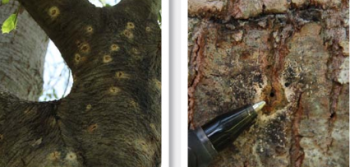
By Miriam Raftery
Photo, left: Damage from polyphagous shot hole borer (PSHB), courtesy of the University of California, Riverside
January 4, 2016 (San Diego)—A destructive new pest, the tiny polyphagous shot hole borer beetle, has attacked over 200 different species of trees in Southern California. Infestations range from avocado groves to ornamental trees in residential yards, entomologists at the University of Riverside report.
According to the San Diego Union-Tribune, that includes thousands of trees in the Tijuana River Valley that have been destroyed suddenly in recent months.
Brian Collins, manager of the San Diego Coastal Refuges Tijuana South National Wildlife Refuge, said, “We had been seeing trees were “looking a little stressed and then all of a sudden, they started dying en masse. This is very scary for me.”
 Shot hole borer beetles are a type of ambrosia beetle believed to have hitched a ride aboard a shipping container from their native Asia to the U.S. They were first found here in 2012. The female beetle drills into trees, lays eggs, and brings along a fungus that the larvae eat. They become adults in a month and the larvae can mate with each other, reproducing without even having to leave the tree. Measuring less than a tenth of an inch in length, shot hole borers (photo, right from UCR, magnified) can be enormously destructive.
Shot hole borer beetles are a type of ambrosia beetle believed to have hitched a ride aboard a shipping container from their native Asia to the U.S. They were first found here in 2012. The female beetle drills into trees, lays eggs, and brings along a fungus that the larvae eat. They become adults in a month and the larvae can mate with each other, reproducing without even having to leave the tree. Measuring less than a tenth of an inch in length, shot hole borers (photo, right from UCR, magnified) can be enormously destructive.
Signs of infestation include perfectly round, tiny entry holes (less than a tenth of an inch in diameter) in most trees. Infection with the fungus can cause a dry or wet and oily dark stain around the holes. Infected trees can also have discolored wood, leaf discoloration and wilting, dead or dying branches.
In avocados and box elders, a white crusty ring called a “sugar volcano” can form, as can wood dust from boring. When bark is scraped away, dark, dead tissue can be found in the insect galleries.
About 33 native species are confirmed as reproductive hosts for the shot hole borer including native riparian species Coast Live Oak, California sycamore, Fremont cottonwood, and red willow. In addition, 52 species of common street trees are hosts, including box elder, liquidambar, and Japanese wisteria.
Though over 200 species of trees have been attacked by the shot hole borer, about 20 of those repel the invaders without becoming infected. In about half the tree species, the beetle transmits the fungus, but doesn’t produce offspring. The fungus interferes with the trees’ ability to transmit nutrients and damage alone can weaken trees, making them more vulnerable to other infestations. Some trees die quickly, while others may only suffer damage initially.
If you believe you have one or more trees infected by the shot hole borer beetle, be sure to call the Agricultural Commissioner’s office to report it. Here is a form to use. You can also read about symptoms in various tree species on this flyer prepared by U.C. Riverside.
To lessen the chances of your trees being stricken, keep them healthy with adequate watering and nutrients.
If infestation occurs only in the branches, but not the trunk, pruning off the infected branches can save the tree. Sterilize pruners after trimming to avoid spreading the fungus.
When pruning or cutting down infected trees, chip wood finely (1 inch pieces or smaller) which kills 98% of infestations, or stack and cover wood tightly with a plastic tarp for at least six months. Never move infected wood or firewood which could potentially be infested with shot hole borers or other destructive beetles, such as the gold-spotted oak borer.
Research is underway but thus far, no pesticide has been found effective against the voracious pests. Much of the research is funded by the California Avocado Growers, who paid $2.3 million thus far to study and fight the dreaded pest. Avocados are a $154 million business in San Diego County, the biggest avocado region in California, which produces 90% of all avocados grown in the United States.
There is hope on the horizon—a tiny parasitic wasp that the U.S. Department of Agriculture is considering importing. .But more research is needed to assure the wasp wouldn’t eat beneficial insects, so any potential importation is at least a few years in the future.







Comments
That's dangerous.